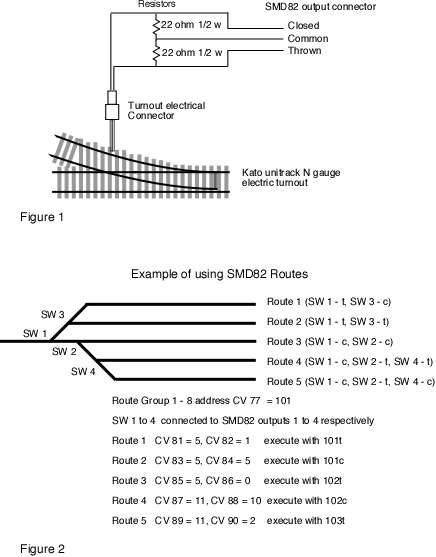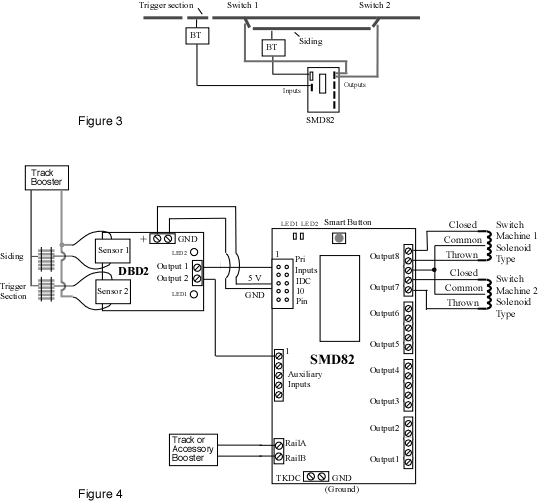|
Team Digital, LLC
SMD82 - Switch Machine Driver Application Information |
| Solenoid Type Switch Machines: The following switch machines have been tested: Atlas HO snap NJI Peco PL-10 "black" Rix Twin Coil Kato N unitrack - requires two external resistors All the machines were tested with a Digitrax DB150 Command Station set to the appropriate scale. The Rix twin coil machine requires tension on the swing arm to keep the internal weight from bouncing off its end stop when the pulse of power is applied. Operating the machine without tension on the arm gives the impression that it is not working correctly. The Kato unitrack electric turnout is a special case since it only has two electrical connections as compared to three for the others. The SMD82 provides power on the common connection, so two resistors are required from the common to power the machine. Figure 1 below shows how the resistors are electrically connected. Warning: the SMD82 output configuration must be set to solenoid type operation for proper operation. Most solenoid type machines require a large pulse of power. The design intent of the SMD82 was to have enough power to be able to activate "snap" any HO/N scale solenoid type switch machine even when they were some what "sluggish". There are several factors that can contribute to poor "sluggish" performance. A few include electrical connections at the driver and the machine, size and length of wire used for connection and mechanical linkage from machine to switch. If you are having problems check these areas. The SMD82 uses screw type terminal connectors for connecting to the switch machines. Wire size recommendations are as follows: If you use the 26 gauge wire try to keep the wire length to each switch machine to under 12 feet. With 24 gauge you should stay under 18 feet. With larger size wire you can have longer wire lengths. |
| Route Features: The internal route feature of the SMD82 is well suited for controlling yard switching. With a single switch command up to eight switches can be controlled at a time. Up to 16 individual routes can be configured, so there is a wide range of combinations available. See figure 2 for an example of route usage in a yard. The SMD82 work very well where 3 point and double slip switches are used. The internal route feature allows for a single switch command to position these types of switches. |
| Local Input: The SMD82 has a number of inputs for local control. You can connect push buttons or toggles switches to control the outputs in a variety of ways. The routes shown in the example in figure 2 could be controlled by push buttons as well from the throttle. You can connect our DBD2 block occupancy detector to the SMD82 inputs to provide some unique capabilities. Figure 3 shows a diagram of how the SMD82 could be used to control siding switches (turnouts). Using primary input 1 and auxiliary input 1 a conditional route can be set up were auxiliary input 1 is dependent on the state of primary input 1. When a train is in a siding and another train crosses the trigger section, the two switches can be correctly aligned. If the siding is not occupied the trigger section has no effect. Figure 4 shows a more detailed diagram for connecting the DBD2 and SMD82. The primary input connector is a 10 pin flat ribbon cable (IDC) type. If you prefer screw type connectors you can use the TSA. |
| SMD82 Known Problems: 10/21/06: Various outputs are closed or thrown after 'power on' even though option 1 or 2 has not been set. This problem is caused by any of the inputs being configurated as active with a 'low to high' transition or a 'on change' transition. When configurated as active with a 'high to low' transition this problem does not occur. SMD82s with this problem can be identified by a single silver mark (1) on the integrated circuit (IC). For solution to the problem contact us. |
 |
 |